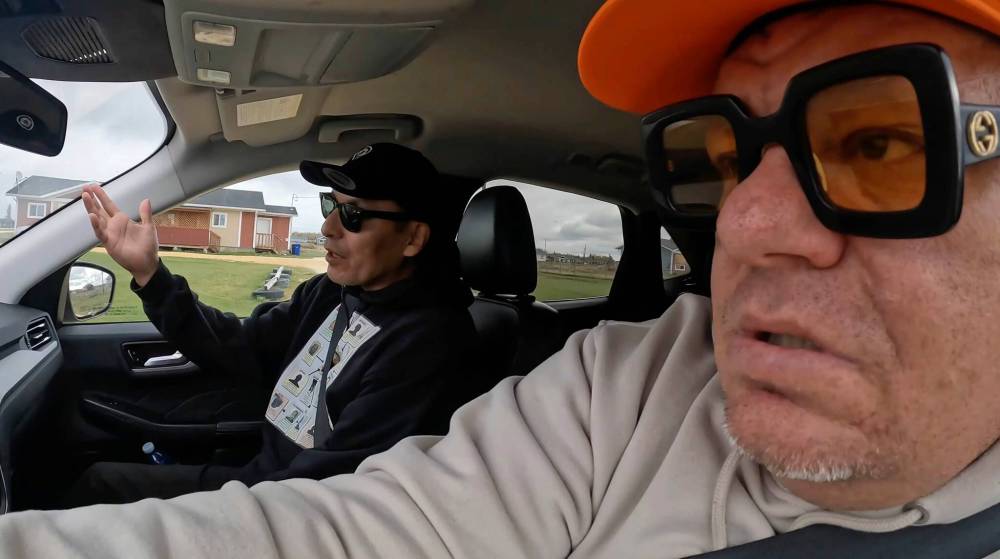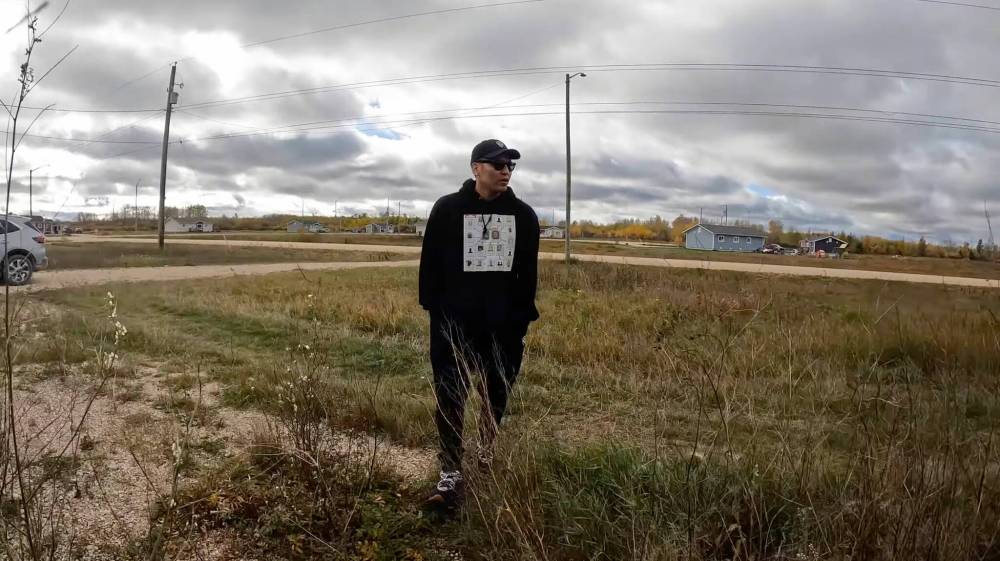Hope in the ‘hood History of violence draws popular YouTuber to Winnipeg, but he discovers ‘good people’, caring community
Read this article for free:
or
Already have an account? Log in here »
To continue reading, please subscribe:
Monthly Digital Subscription
$0 for the first 4 weeks*
- Enjoy unlimited reading on winnipegfreepress.com
- Read the E-Edition, our digital replica newspaper
- Access News Break, our award-winning app
- Play interactive puzzles
*No charge for 4 weeks then price increases to the regular rate of $19.00 plus GST every four weeks. Offer available to new and qualified returning subscribers only. Cancel any time.
Monthly Digital Subscription
$4.75/week*
- Enjoy unlimited reading on winnipegfreepress.com
- Read the E-Edition, our digital replica newspaper
- Access News Break, our award-winning app
- Play interactive puzzles
*Billed as $19 plus GST every four weeks. Cancel any time.
To continue reading, please subscribe:
Add Free Press access to your Brandon Sun subscription for only an additional
$1 for the first 4 weeks*
*Your next subscription payment will increase by $1.00 and you will be charged $16.99 plus GST for four weeks. After four weeks, your payment will increase to $23.99 plus GST every four weeks.
Read unlimited articles for free today:
or
Already have an account? Log in here »
On a recent quiet night, I was idly scrolling YouTube when a video popped up in my recommendations. It was a new upload from popular Toronto travel YouTuber ChrisMustList, posted on his more casual second channel, ChrisMustList RAW, and the title seemed to blare right off the screen.
Inside Winnipeg’s Most Dangerous Hood.
At first, it seemed surprising that the gregarious YouTuber — real name, Christopher Hughes — should come here. Since 2020, Hughes has made a career out of visiting some of the world’s most struggling places. His main account boasts more than 590,000 subscribers. Videos of his explorations of countries such as Haiti and Afghanistan have topped one million views.
The titles of his videos are, as YouTube algorithms encourage, sensationalistic, emphasizing danger. (The Real Streets of Hamilton — City of the Living Dead!) His journeys have embroiled him in various kerfuffles. Last year, he was arrested in Trinidad and Tobago and charged for some of his filming, a legal battle that is still ongoing.
That Hughes should come here gave me pause. At its best, the “danger tourism” genre is — despite its titles — balanced and human, challenging viewers to confront stereotypes about places and peoples. It allows audiences to reach across chasms of culture and fortune, and connect with the honest joys and struggles of their fellow humans.
But at its worst, the genre can be racist and rankly exploitative, peddling images of suffering for individual profit, and even weaponizing those images for political ends. I wasn’t familiar with Hughes, so, as I pressed play, I felt a knot in my stomach, not knowing what to expect.
Hughes’ first dispatch from Winnipeg opens with little action. He and his son devour plates of roti at downtown institution Famena’s; they drive aimlessly around Main Street and the North End, pausing for a friendly chat with a man panhandling on a street corner.
Then they stop near Selkirk and Salter, where a man in a red cap hops into the car.
“I’m Randall,” he introduces himself.
As a boy, Randall Traverse grew up in the North End, close to where he met Hughes, though he hails from Lake St. Martin First Nation. An avid reader and self-taught student of history and philosophy, he dives into podcasts and other media that catches his interest. Over a year ago, that curiosity led him to discover Hughes’ videos.
“As soon as I learn something new, I just latch onto it,” says Traverse, 46, chatting earlier this week over coffee at a Kenaston-area restaurant. “I’m always asking the next question, always wanting to know more. Or, I want to go meet someone like Chris.”
YOUTUBE Randall Traverse provided a guided tour of Winnipeg’s North End and his home community to Christopher Hughes, dispelling misconceptions along the way.
So in early fall, when Traverse saw a post that Hughes was planning a cross-Canada road trip, he sent the YouTuber a message, offering to help show him around Winnipeg, and maybe introduce him to some people. They could go anywhere, Traverse offered, see anything, talk about whatever Hughes wanted.
“I was just willing to go wherever he wanted to go,” Traverse says. “He’s a guest in our house, so I just wanted to make him feel comfortable, you know?”
From the moment Traverse appears in Hughes’ videos, his calm, measured commentary shapes Hughes’ trip. When Hughes says he’d heard it was too dangerous to get out of the car in the North End, Traverse gracefully corrects him: “It’s OK to get out of the car,” he replies. “It’s not that bad … a lot of people are good people here.”
That assertion — there are a lot of good people here — proves the theme of Hughes’ visit.
At Hughes’ request, they drove to Traverse’s home in Lake St. Martin, where they chatted amicably with residents and, having never visited a First Nation, Hughes expressed surprise at the tidy new houses and relative normalcy of life on the reserve.
In Winnipeg, Traverse connected Hughes with some of those “good people” he knew, including Jeremy Raven and Terrence Morin, both Indigenous men who had been incarcerated and now devote their lives to helping others rise out of poverty and addiction.
Traverse also facilitated Hughes’ long interview with a friendly man who lives at an encampment near Thunderbird House. That interview, unvarnished, gives the man ample space to speak honestly of both the struggles and the humanity of life on the street, sharing his perspective for Hughes’ hundreds of thousands of viewers.
“Just because we’re out here and down like this, doesn’t mean we’re not human,” the man says, explaining how the people living at the camp take care of each other. “Here, we’ll go around and make sure that everybody eats, that they have enough blankets at night and their tents are fixed up alright.”
In his final of his four video dispatches from Manitoba, Hughes acknowledged that the city’s hard reputation drew him: “The reason I came here is because of the violence,” he tells Morin. “I looked at every stat, it says Winnipeg is the most dangerous city in Canada.”
That may have been what drew him, this reputation of the city at its worst. It’s what his viewers tune in for, after all — curious to get a glimpse of places they can’t imagine going, and lives they can’t imagine living.
But if this is the image of Winnipeg that Hughes’ fans came to see, then thanks in large part to Traverse, they also see, in a way, Winnipeg at its best.
They see how, even where people have the least, there is community, and people looking out for each other and people doing what they can to heal the city where it hurts.
“I feel like he goes out and just shows what’s going on out here,” Traverse says, of the videos. “That’s how I take it, and I feel the same way. When I go to the reserve, I’m going there just to say, ‘we’ll just straight record. Whatever happens, happens.’ And let the people that are watching take away from it whatever they want, right?”
In the days since the videos were released, Traverse has heard from many folks in both Lake St. Martin and Winnipeg. The feedback has been widely positive: “Everybody loves it,” he says. (That said, some assumed he’d been hired by the reserve’s chief and council to show Hughes around: for the record, he wasn’t.)
When asked what he hopes viewers take away from Hughes’ videos, Traverse speaks less of those abroad and more of those closer to home. In that, he’s informed by his own long journey: as a youth, during a run-in with the law, he was sentenced by the trailblazing Anishinaabe judge, Sen. Murray Sinclair.
“I was thinking to myself, ‘I’m looking for a white judge,’” he recalls. “That changed my perspective. Just him sitting there, that showed me the possibility. So, I wanted to be just like that. I was thinking I wanted to do better in my own way.”
YOUTUBE Randall Traverse provided a guided tour of his home community of Lake St. Martin to YouTuber Christopher Hughes.
In much the same way, he says, being able to connect with Hughes and introduce him to people like Raven and Morin, and the good people living in the encampment, helps lift those voices to where others in our community can see them. Without those voices, perhaps the videos would have been very different. With them, there is a note of hope.
“When people see examples like that, like you never know the effect you might have on other people, just them seeing you,” he says. “It was so good for anybody that’s watching it. They’re going to think, man, I could do that. Because a lot of people have been there like they did that, too.
“That’s what we want to do. We want to reach those people. We want to do our part. So, that’s why connecting with Chris, meeting him and then saying, like, ‘I want you to meet these good people here …’ that’s me doing my part.”
melissa.martin@freepress.mb.ca

Melissa Martin
Reporter-at-large
Melissa Martin reports and opines for the Winnipeg Free Press.
Every piece of reporting Melissa produces is reviewed by an editing team before it is posted online or published in print — part of the Free Press‘s tradition, since 1872, of producing reliable independent journalism. Read more about Free Press’s history and mandate, and learn how our newsroom operates.
Our newsroom depends on a growing audience of readers to power our journalism. If you are not a paid reader, please consider becoming a subscriber.
Our newsroom depends on its audience of readers to power our journalism. Thank you for your support.

